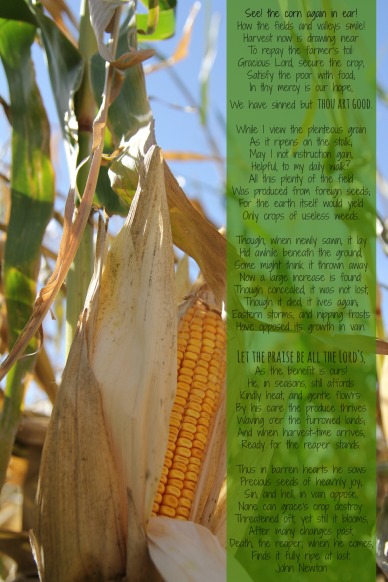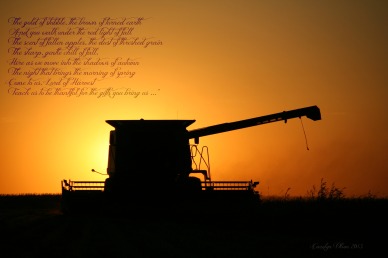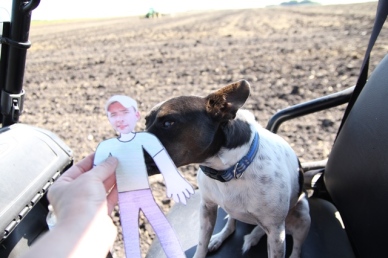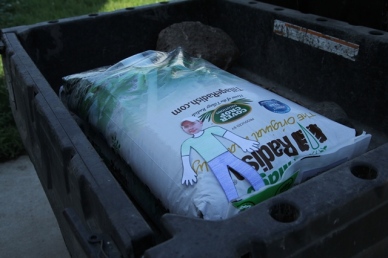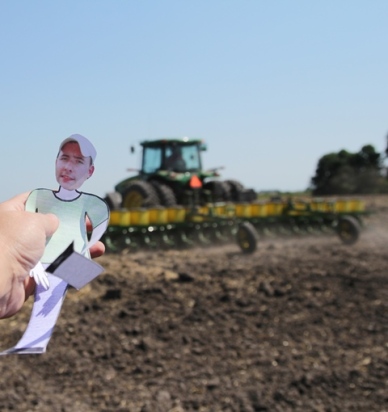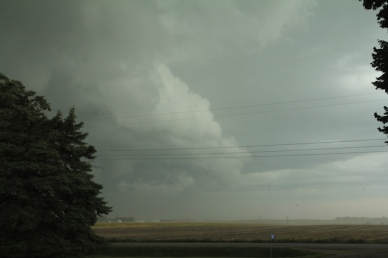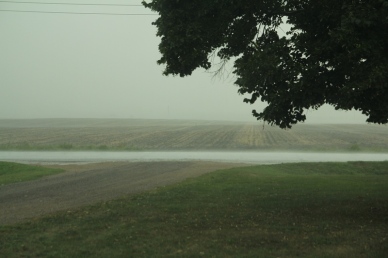Tag: farm
Top 10 Things I Love About Farm Life
Top 10 lists are fun write out. I thought it would be fun to put photos with my top 10 list of things I love about farm life.
10. Fresh pork. We are pig farmers, so we always have a freezer full of fresh pork. Bacon and pork chops have to be the favorites. Grilled pork chops and Marshall Salad pair very well together. Follow the link for the salad recipe, shown here with Beef Strip Steaks to show a little love to our beef friends.

9. Spring. After long winters of snow, ice, and wind, it is so good to be able to work outside in just a long sleeved shirt. The smell of freshly turned soil is so awesome. After the crops are planted, waiting for the first shoots to push through the ground seems to take forever. Suddenly, there is a green haze over the fields. We wait eagerly for the first signs that you can “row” a crop.

8. Watching crops grow. Growing our crops is our business, but that doesn’t mean we’re on autopilot like some robotic device. I worry. A lot. I worry about getting enough rain, too much rain, hail storms, wind storms. In the fall, I worry about early snow storms. There are things we can do to give our crops the best chance at reaching their full potential: testing the soil and the manure to make sure we are applying the correct amount of manure in the fall, using cover crops to hold top soil in place over the winter, waiting to plant until the soil temperatures are ideal in the spring, and timing our weed control methods to have the least impact on the plants (check out this flame weeding video for one of our methods). The rest I shouldn’t worry about, but I’ll admit, I have troubles giving all of that to God.
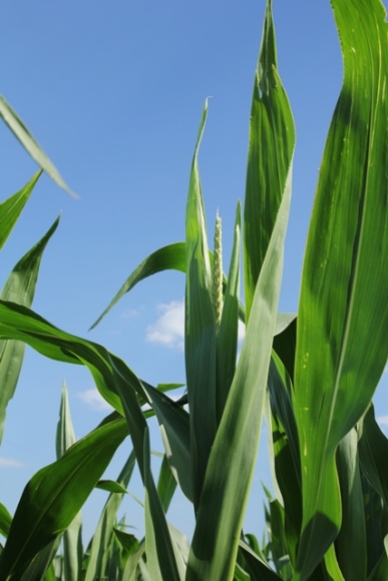
7. Meeting cool people. Jonathan and I have had the privilege of meeting some pretty cool people because we sell some of our corn to a place that makes vodka. Dean Phillips, of Phillips Distilling has visited our farm, and learned about the combine, and what it takes to grow the corn they use. Joe and Connie from Chatham Imports have also visited our farm, learning about us and what it is we do. You can read about that in this series -The Power of Bundt Cake Part 1, Part 2, Part 3, and Part 4. There have also been a few advertising agencies that we have met. Jonathan was even interviewed for the Prairie Vodka website. That was a pretty cool experience.

6. Work hard, play hard. We love getting together with family. If it is at a lake, all the better. I like to relax a bit and fish, but Jonathan loves to play on the jet skis. We look forward to the few days in the summer where we are free to leave the farm and relax.
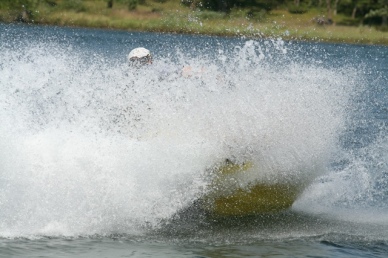
5. Wildlife. Who doesn’t like to watch wild animals in their habitat? This year, I have watched a fox and her two kits near our grove of trees, a doe and her fawn grazing in our yard, and a coyote who casually walked away while I was working in a field near it’s home. I have watched a dozen hawks circle in the sky while preparing soil for planting, I watched a cicada drying its wings after its metamorphosis, and have seen butterflies softly flitting around in the yard. Watching the wildlife makes me appreciate the beauty all around us.
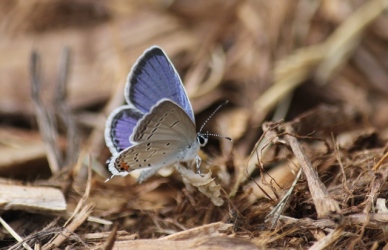
4. Sunsets. Living on the prairie has its advantages. The skies are endless, and most nights we are treated to wonderful sunsets. In the summer, the sunsets seem to go on forever. To see some gorgeous North Dakota sunsets, visit my friend, Katie Pinke’s blog. She has a blog post about 14 Late Summer North Dakota Sunrises and Sunsets. One thing I love about working outside in the evening, is the way the skies can change so quickly. From a flaming red and orange, to a soft pastel pink, to a mix of purple and deep pinks all a matter of minutes.
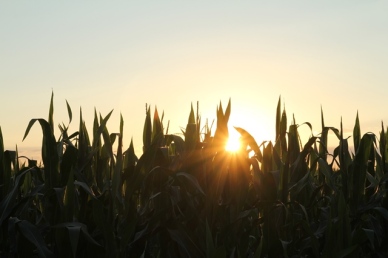
3. Driving large pieces of machinery. I was not meant to drive a little car like a Toyota or a Honda. I like to drive tractors and combines. You can see more when you are sitting up high. Maybe that’s why I like driving pickups more than cars. I do love my minivan, but I get a little embarrassed when we bring it in for an oil change and there are corn stalks stuck on the bottom from driving out to the combine. I was pretty nervous to learn how to drive the combine, but now I love it! We had our combine all set up for our Century Farm Celebration and our county’s I Met a Farmer Tour. It’s a fun way to introduce people to farming, and they think it’s cool that I get to drive it.
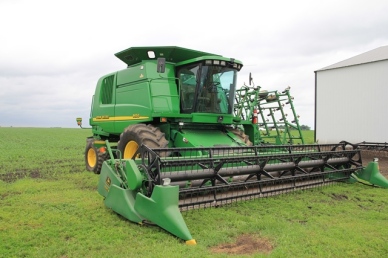
2. Harvest! I love harvest. This is the time of year when we see the results of all the labor that was put into the crop throughout the growing season. When we plant the seeds in the spring, we are hopeful that we will have favorable weather, few bad storms, and be able to harvest enough so we will be able to farm again next year. We are thankful for every bushel of grain that goes into the bin. Yes, the hours are long, the pace is frantic at times, and there is always the worry of an early snowstorm, but those are the things that keep it from being boring. This is one of my favorite harvest photos, paired with a harvest prayer. It was also shared as a Wordless Wednesday photo a few weeks ago.
So, what is the number 1 thing I love about farm life?
1. Working every day with my best friend, Jonathan. Yeah, yeah. It’s sappy, I know. But I wouldn’t trade this life with anyone. Jonathan and I celebrated our 25th Wedding Anniversary in August. We were married during a drought year, so we came home from our honeymoon a day early to help with corn harvest. This city girl learned quickly how to move wagons, and unload the corn into the bins. Jonathan and his dad are very patient teachers, which made the transition so much better. I later graduated to running the stalk chopper, then the chisel plow, the field cultivator, and finally the combine. With every new skill, Jonathan has been able to calm my nerves, and give me confidence to tackle the next big thing. I have grown from a shy 20 year old newlywed into a mouthy 40 (something) gray haired lady. I don’t think he regrets that. I don’t care what you want to do in life, a supportive family makes it much easier. To Jonathan, thank you for being a great man of God, husband, teacher, jokester, and friend. I love you!

Tillage Radish Cover Crop Update
The neighbors have been asking, so here is an update on our Tillage Radish and Oat cover crop.
We have received more rain this fall than we have during the same time period the last two years, so our cover crops have gotten off to a great start. We planted this field on August 31st. You can read about the process here.
Neighbors are starting to ask what we have growing in our field. They know one of the plants is a small grain (wheat, oats, barley, and rye are considered small grains), but they are not sure what the other crop is that was planted in rows. This made me think that maybe the rest of you would like to see what our neighbors are seeing.
This first photo shows the tillage radish planted in rows with oats in between the rows.
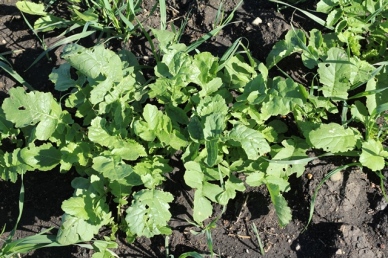
This is the overview of the field. You can see how the Tillage Radish is more noticeable in the oats.

The radish leaves are broad, and very different from other crops grown in our area. The leaves and the root will almost disappear completely over the winter, leaving the nutrients behind in the soil.

I wanted to see how big the radish taproot was 38 days after planting. To make sure I was getting a random radish, I walked out into the field, and plopped my shovel near a row. That was the one I would dig up.

The soil is still pretty moist after our weekend rains, so digging was easy. I wanted to get as much of the taproot as I could, so I teased it out of the loosened dirt.We are in a wind advisory, so holding the radish still enough for a photo outside was a bit of a challenge.

I walked back into the house to measure the length of the taproot. The diameter is just shy of 1/2 inch at its widest. I was impressed that the roots measured at 8 1/2 inches already!

I believe I was able to tease out the entire taproot, and didn’t break off the end, but it was difficult to tell without a magnifying glass. Here is another view of the root length.

As long as we don’t have a hard freeze (around 20 deg F), the radish will continue to grow both in diameter and length. I’ll take a few more photos in a couple of weeks, and give you another update. In the meantime, we are getting ready to finish harvesting our last field of soybeans.
Teaching Flat Ryan About Cover Crops
FlatRyan is the brainchild of a few fabulous agvocates who took over the Agriculture Proud blog while Ryan is finishing his Master’s degree. You can read all about it and learn how to participate here. This blog post first appeared on Agriculture Proud on September 18th.
On the last day of August, #FlatRyan got in on a little cover crop planting on our farm. Saturday was pretty warm for Minnesota standards, but it was a good day to get some work done. We do things a little differently than most of our neighbors, which sometimes leads to many questions. We farm organic row crops, so we follow different rules. One of those rules is a three crop rotation. Each year, we have approximately one-third field corn, one-third soybeans, and one-third small grain (wheat, and a mix of barley & field peas). We use cover cropping to help lock in nutrients, for weed control, and to prevent soil erosion.
The field we were working in had been a barley and field pea field. The barley and peas had been harvested, the straw baled, and manure applied for next year’s corn crop. The manure was worked into the soil with a deep till chisel plow before we seeded oats with a broadcast spreader. The oats were worked in with the field cultivator, which was set to go only an inch or two deep. We were then ready to try something we’ve never done before.
#FlatRyan, Pongo the Rat Terrier, and I took the Ranger across the road to check in with Jonathan and see how he was doing.
We have been seeding Tillage Radish with our oats for a few years. Tillage Radish is different from the radishes you grow in your garden. A Tillage Radish has a pretty strong tap root that can break up compacted layers in the soil. The root keeps nutrients locked up over the winter, and when the plant dies, it leaves a hole the size of the radish that the corn plant’s roots will be able to use to grow bigger.
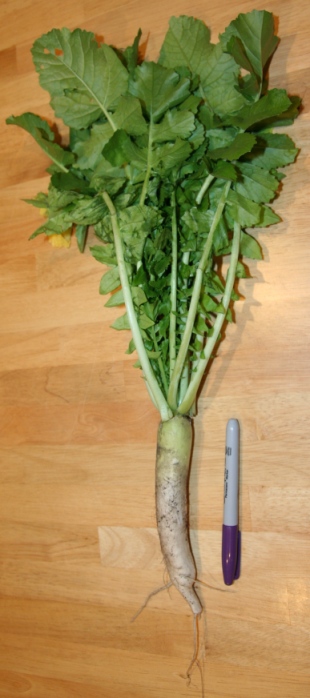
Last year, we attended a cover cropping seminar, and heard about a study that was being done where they planted the Tillage Radish seed with the corn planter, using sugar beet plates. To us, it made total sense. Using GPS mapping in the tractor, we have the capability of planting the corn directly over the rows that we planted the Tillage Radish in. We weren’t sure exactly how well it would work, or if the Precision Planting system would be able to accurately measure how many seeds per acre we were planting. This is where #FlatRyan joined us.
When Jonathan got to the end, we needed to check the planter boxes to see if he was planting the correct number of seeds per acre. Here, #FlatRyan is looking to see how much seed is left in the first box. 
It was decided that Jonathan needed more seed, so #FlatRyan, Pongo, and I headed to the seed shed in the yard. Many of our bags are white with no markings, so reading a seed tag is important. Tillage Radish comes in colorful bags, so they were easy to spot.
We loaded a couple of bags into the back of the Ranger, and went back across the road to meet the planter once again.
Jonathan split the 50 pounds of seed between the 16 boxes, and we put the other bag in the rock box. We still weren’t sure how much would be needed to finish this field. #FlatRyan was so excited by how well the planter was working to plant the radish seeds that he was kicking up his heels!
Not long after Jonathan finished planting this field, the clouds rolled in, and we were blessed with ½ inch of rain!
This is how the field looked 10 days after we planted the Tillage Radish. Looks like both the oats and the radish are off to a good start!
After #FlatRyan’s weekend with us, Jonathan and I seeded and planted our wheat fields the same way. In the last field, we planted 46 acres of Tillage Radish like we did in the barley and pea field. We were racing with the rain on the last day, so we decided to broadcast seed the oats and Tillage Radish on the remaining 100 acres. Then, for good measure, we left about 8 acres as a check strip. That way, we have all three methods in one field. Next spring we will till the field with the field cultivator, which will disturb the decayed matter and small weeds on the surface, but will preserve the channels created by the Tillage Radish.
We hope #FlatRyan had fun helping us with our experiment! This is one experiment that will take a long time to see the results, but in the meantime, it does keep the neighbors guessing about what we’re up to!
To see more of Flat Ryan’s adventures, click here. He’s had a lot of fun, and has learned some amazing things so far!
Throwback Thursday – Thankful for Modern Tractors!
Soon!
Wordless Wednesday – Just What We Needed
Heading to the Minnesota State Fair?
This last week has been incredibly warm and humid, so you may have put off plans to head the the Great Minnesota Get Together. This weekend – the final weekend of the fair – is supposed to be beautiful! It would be a great time to check out all the awesome agriculture exhibits at the Minnesota State Fair!
Our family has been attending the fair for quite a few years. We started volunteering in the Oink Booth when we were members of our county pork producers association. We had so much fun handing out pig ears and answering questions about our farm, and about raising pigs in Minnesota. After our daughters became members of 4-H, we started volunteering at the Farm Bureau barn for the days they would be competing at the state fair. This is the first year that our daughters are out of 4-H, but that doesn’t mean our state fair days are over!
On Sunday, September 1, Jonathan and I will be volunteering in the Farm Bureau Building from 1-5 pm. We are excited to be working with Bryan and Marytina Lawrence from Princeton. (To learn more about the Lawrence’s farm, click here.) We’ve known Bryan and Marytina since we first became involved with the Farm Bureau’s Young Farmers & Ranchers program. Marytina now works with the Speak for Yourself program, which is one of the things I’m involved in.
The Speak for Yourself program does a great job of helping farmers feel comfortable telling their story in front of others. Throughout the fair, there have been several SFY participants who have volunteered to work in the Farm Bureau Building. I hope you will come out on Sunday to ask us questions, or check out the building on Monday when Wanda Patsche will be working. Be sure to also read her blog entry about the state fair before you go!
One of the reasons why I love volunteering at the Farm Bureau Building is meeting people from all over the world. Last year, there was a family from Europe who stopped by to check out how we farm compared to how they farm. When you walk into the building, you will be greeted by one of the volunteers, and asked if you would like to answer a few questions in order to win a prize. The search for the answers will take you around the displays in the building, helping you to learn more about agriculture in Minnesota. After you answer all the questions, you will receive an insulated lunch bag. There is also a recipe booklet available for those who like to cook. There are drawings for children’s books, including “Little House on the Prairie”, so make sure to sign up for your kids!

The Ag Cab Lab-Combine is also in the Farm Bureau Building. This activity is great for kids of all ages. Sit inside the cab and see what it is like to combine different crops. If you would like to see what a farmer does while driving a tractor, head on over to the CHS Miracle of Birth Center where the Ag Cab Lab-Tractor is located. While there, check out the new livestock babies that have been born during the fair. The Miracle of Birth Center is another great place to learn about agriculture in Minnesota. The veterinarians, staff, and student volunteers have been working really hard this week to make sure the animals are well cared for in the heat. Ask the FFA students about the animals they are with. They would love to answer your questions!
Besides the Oink Booth that is found in the pig barn, check out the Moo Booth, and the Baa Booth. The Moo Booth has activities going on throughout the day on Sunday, including milking demonstrations. The Baa Booth is located in the sheep barn, and has some fun facts about raising sheep. All three of these booths have farmer volunteers working in them, and they, too, would love to answer your questions.
Another great area to learn about agriculture is the Dairy Building. Not only will you be able to see Princess Kay of the Milky Way’s Butterhead, but you may even get to see Princess Kay herself! The ice cream that you can buy in the Dairy Building is awesome. You can walk around inside the building and pick up recipes from other livestock organizations. Make sure you talk to the people handing out the recipe cards. They all are passionate about what they do!
Pretty much every year, we also take a walk through the Agriculture Horticulture Building to find the Minnesota Crop Improvement Association booth. Jonathan has won many ribbons on seeds that have been submitted. There is a display there about what the seeds from different plants look like. Do you know the difference between grass seed and flax seed? This is the building that houses the contests for Christmas trees, Bees & Honey, Farm Crops, Flower Show, Fruit & Wine, and Vegetables & Potatoes. It is fun to walk through and see the entries, especially the giant vegetables!
There are so many great agriculture stories at the Minnesota State Fair. I would love to hear what you learned when you checked out all the fun displays and the barns – add it to the comments below.
See you at the Fair!
25 Years Later, Still in Love!
Today Jonathan and I are celebrating our 25th wedding anniversary. I am so thankful that God brought us together…and that Jonathan was wanting to be a pig farmer and not a dairy farmer. I am so not a morning person.
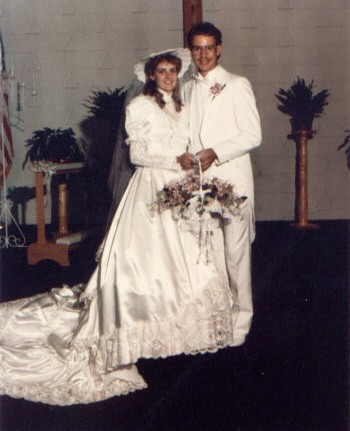
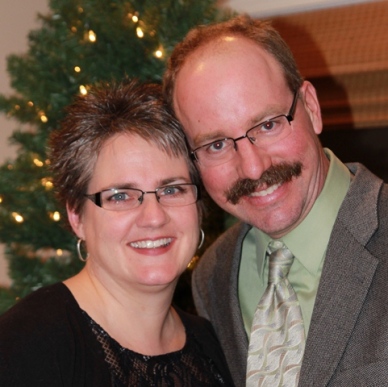
Our hair may have turned a bit gray – or thinned some. We’re both a bit fluffier – me more than him. We move a little slower after a day of filling the planter. But I think it’s safe to say, we’re still in love after 25 years. I love you, Jonathan!
If you want to read more about how this city girl became a farm wife, read my very first ever blog post, Why I Care.
Why Is It…?
My Twitter feed is increasingly making me crabby. I follow a pretty diverse group, both conventional and organic farmers, a variety of agriculture businesses, and a wide range of bloggers. Why is it that every morning, my twitter feed is clogged with more conventional farmers putting down organic agriculture? The organic farmers I follow don’t share near the non-GM stuff as what the conventional farmers are sharing. Even some people that work for groups that are supposed to support all of agriculture are sharing more anti-organic graphics. I thought that when you claim to be an “agvocate”, you would be speaking for agriculture, not pitting one method against another.
I belong to a speakers group through the Minnesota Farm Bureau called Speak for Yourself. In our training sessions, we are taught to tell our farm story through the use of Power Point presentations. We are given the opportunity to create our presentations, then give them to our class for practice. We are to focus on our farm, and not worry about what our neighbors are doing. That way, when we go out and speak to groups like a Lions Club or Rotary Club, we are putting a face on farming. We are taught to present a positive picture of agriculture, and to be a resource to those who we have shared our story. As an organic farmer, I have been able to give my presentation to a group that had quite a few Monsanto employees in it. They enjoyed the presentation because I focused on my farm, without putting any commentary about other farms into my presentation. This is proof that speaking about only my farm can bring a clear message.
Do you hear a lot of people talking about the Paleo diet, vegetarianism, veganism, the Whole30 Challenge, and other restrictive diets? Why is it that those diets are acceptable, yet people who choose to eat organic foods are called anti-science? Last time I checked, it was not advised to go on a diet that eliminates whole food groups or are too restrictive. There are many scientific articles relating to the long term viability of vegan diets, for example. If I were to follow in other farmer’s footsteps, I could post a graphic that I found on the internet. After all, whatever is on the internet has to be true, right?
A few of my friends have told people that they can go ahead and waste their money by paying extra for the organic label. Really? How is that attitude fostering a positive image of agriculture? These same people are so excited when the farmers market opens and they can finally get fresh produce. I’m sure you could get tomatoes from the grocery store for less. So what if they are a little more pale and pulpy than the organic ones, or the ones fresh from the farmers market. Sounds a little bit hypocritical to me. No wonder consumers are confused.
Speaking of consumers, I see a lot of the anti-organic graphics and studies aimed at them. Talk about mommy guilt. Conventional farmers are just as bad as organic farmers if you really look at the graphics being shared. Why is it that only the end products are looked at when people are arguing over methods? Isn’t there a grower in there somewhere that is preparing the soil, buying seeds, planting, nurturing, and harvesting? In my mind, there is a whole lot more to these systems than just the end product.
This brings me back to the whole organic farmers are anti-science statements that make me cringe. We are anti-science because we choose not to use a certain seed technology? What the heck? That is such an insult. We use science to determine what our soil profiles are, how much manure needs to be applied, how much nitrogen the corn plants are taking up, when to flame weed the corn, and what tillage methods we need to tweak. We use more technology in our tractors than most of our neighbors. So, using the same logic, we can call all farmers who don’t use GPS guidance systems and field mapping anti-technology, backwards, and old, right? Why is it that conventional farmers feel the need to call others names because they farm different? It sounds a lot like school yard bullying, and makes us all look stupid.
Why is it so hard to resist hitting the share button when you know it’s going to hurt your farming friends and neighbors? You tell your story, I’ll tell mine, let other farmers tell theirs. When we start to tell each other’s stories, the whole agriculture message gets all mucked up, and consumers don’t know who to trust. We need to resist the temptation to post things that prove we are “right”. Who says that anyone is wrong? What is right for you will not be right for me. Even if we farmed using the same methods. Your soils, climate, personality…everything about you is different than me. That is what is awesome about being a farmer in the US. We have the freedom to farm how we like. We have the freedom to grow what we want. We have markets available to sell our products. There is so much good happening in agriculture, why is it that we feel like we need to put others down?
Let me leave you with one of my favorite quotes:
“To be one, to be united is a great thing. But to respect the right to be different is maybe even greater.” -Bono
